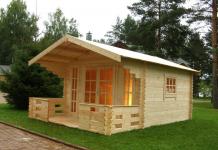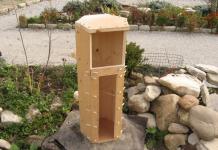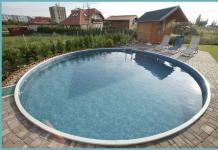The forms of poetic rhythm are varied. Russian versification is based on syllabic-tonic (syllable-stressed) system versification.
Syllabo-tonic versification is a way of organizing a poem in which stressed and unstressed syllables alternate in a certain order, unchanged for all lines of the poem. The rules of syllabo-tonic versification were developed by Vasily Kirillovich Trediakovsky (“A New and Brief Method for Composing Russian Poetry”, 1735) and (“Letter on the Rules of Russian Poetry”, 1739). By the middle of the 18th century, this way of organizing a poem became dominant in Russian poetry.
Under poetic size understand the rules for alternating unstressed and stressed syllables in a verse, in other words, the alternation of feet.
Foot - this is a sequence of one or more unstressed (weak) and one stressed (strong) syllable, alternating in a certain order. For classical sizes, the foot consists either of two syllables (trochaic and iambic - two-syllable poetic meters), or of three (dactyl, amphibrach and anapaest - three-syllable poetic meters). The foot is the smallest structural unit of a verse. The number of feet in one poetic line is taken into account when determining the poetic size. The number of stops corresponds to the number of rhythmic stresses in one line.
In Russian versification, they distinguish five verses : trochee, iambic, dactyl, amphibrach and anapaest.
Chorey, or trochee(from Greek horeios - dance) - two-syllable size, where rhythmic stresses fall on odd syllables. Chorea foot schematically looks like this: | – (the sign “|” denotes the stressed syllable, and the sign “–“ is the unstressed one).
A storm covers the sky with mist,
Whirlwinds of snow twisting…
(A.S. Pushkin)
| – | – | – | –
| – | – | – |
In this case, we have an example of a 4-foot chorea. (It should be borne in mind that rhythmic stresses do not always coincide with ordinary verbal stress, and sometimes there can be two rhythmic stresses in a word - in the example given, the word “snowy” has two rhythmic stresses. An “extra” rhythmic stress is called pyrrhic).
Yamb(from the name of the ancient Greek musical instrument) - two-syllable size, where rhythmic stresses fall oneven syllables.
The iambic foot schematically looks like this: – |
My uncle has the most honest rules.
When I seriously fell ill ...
(A.S. Pushkin)
– | – | – | – | –
– | – | – | – |
In this case, we have an example of iambic 4-foot.
One of the heroes of the novel by Ilf and Petrov "The Golden Calf" - Vasisualy Lokhankin - communicated with those around him exclusively in iambic pentameter:
I have come to live with you forever.
Fire, fire brought me here.
(I. Ilf, E. Petrov)
– | – | – | – | – | –
– | – | – | – | – |
This is an example of iambic 5-foot.
Comedy "Woe from Wit" written diversified iambic, because the text of the work uses a different number of stops in iambic lines:
Be silent!
Terrible age! Don't know what to start!
All managed beyond their years.
And more than daughters, but good-natured people themselves.
We were given these languages!
(A.S. Griboyedov)
– |
– | – | – | – | – |
– | – | – | – | –
– | – | – | – | – | – |
– | – | – | – |
That's an example iambic polypod. In each of the lines from one to six stops.
Dactyl(from the Greek daktilos - finger) - a three-syllable poetic size, where rhythmic stresses fall on 1st, 4th, 7th, etc. syllables.
The dactyl foot schematically looks like this: | – –
Glorious autumn! Healthy, vigorous
The air invigorates tired forces ...
(N.A. Nekrasov)
| – – | – – | – – | –
| – – | – – | – – |
That's an example 4-foot dactyl.
Amphibrachius(from the Greek amfibrahus - short on both sides) - a three-syllable poetic size, where rhythmic stresses fall on 2nd, 5th, 8th, etc. syllables.
The foot of amphibrach looks like this: – | -
To the father, all trembling, the little one clung.
Having embraced, the old man holds and warms him.
(V.A. Zhukovsky)
– | – – | – – | – – |
– | – – | – – | – – |
That's an example 4-foot amphibrach.
On the blue waves of the ocean
Only the stars will shine in the sky...
(M.Yu. Lermontov)
– | – – | – – | –
– | – – | – – |
That's an example 3-foot amphibrach.
Anapaest(from the Greek anapestos - reflected back, i.e. reverse to dactyl) - a three-syllable poetic size, where rhythmic stresses fall on 3rd, 6th, 9th, etc. syllables.
The foot of the anapaest looks like this: - - |
Name me a place like this
I didn't get that angle...
(N.A. Nekrasov)
– – | – – | – – | –
– – | – – | – – |
That's an example 3-foot anapaest.
Poetic dimensions are a headache not only for philological students who study theory of literature, but even some writers. The poetic arsenal of Russian poets has five actively used sizes: trochee, iambic, dactyl, amphibrach, anapaest. There are others, such as Spondey. What it is? And how do some differ from others?
Poetic size- a way of sound organization of a verse, a rhythmic form of a poem.
If we give a definition in simple language, then poetic size is the alternation of unstressed and stressed syllables in a verse. The easiest way to learn how to determine the poetic size is to remember the rhythmic pattern of each size.
Foot- a unit of measure for meter.
The foot consists of several syllables, only one of which is stressed, the rest are unstressed. The number of stressed syllables in a verse corresponds to the number of feet (with the exception of such a size as spondey, in which two stressed syllables can be adjacent).
Two-syllable feet: trochee and iambic are two-syllable sizes or, as literary critics call them familiarly, two-syllables.
Trisyllabic feet: dactyl, amphibrach, anapaest - these are trisyllabic sizes or, for short, trisyllabic.
Learning to place stress and determine the size of the verse
To learn how to determine the size of any poem, you need to count the number of stressed and unstressed syllables and draw up a rhythmic pattern of the verse.
Everyone knows that in one word - one stress. But in a line of poetry in one word there can be several rhythmic stresses. For example, in the quatrain "Mch A tsya t at chi, w Yu tsya t at chi/ Nevid And my moon A/Lighting A no sn e g years at chi/M at tno n e bo, n O whose m at tna" stressed vowels are in bold. This is the so-called verbal stress, that is, the “native”, habitual stress of the word. But if you read this text like a rhyme, highlighting each syllable intonation, it turns out that there are several rhythmic stresses here:
"Mch A tsya t at chi, w Yu tsya t at chi" - here the word stress corresponds to its rhythmic stress.
"Invisible moons A" - but here it’s more interesting, because in the word “invisible And mkoyu" to the native verbal stress on the second "and" in the syllable "dim" is added rhythmic stress on "e" in the syllable "not" and the final "yu". In the word "moon" verbal and rhythmic stress are the same.
"ABOUT light A no sn e g years at whose” - here, too, one can observe the emergence of rhythmic stress in an unexpected place: the first syllable “o” in the word “illuminates” when reading a line in the manner of a rhyme is acoustically highlighted.
"M at tno n e bo, n O whose m at tna" - in this line the verbal and rhythmic stress correspond to each other.
To draw up a rhythmic pattern (scheme) of a verse, you need:
1) place word stresses in each line, that is, native stresses in all words (with the exception of prepositions).
2) place rhythmic stresses, that is, highlight those vowels that stand out acoustically when read and also sound like percussion. When arranging rhythmic stress, prepositions are also taken into account.
3) make a diagram. The scheme of our quatrain "Clouds are rushing, clouds are winding ..." will look like this: _U|_U|_U|_ U, since the stressed syllable is indicated by an underscore _, and an unstressed syllable by a quote U. Separate the feet from each other with a straight vertical line |.
Non-literary method to determine the size of a poem
1) Number all the syllables in the line.
2) Highlight, that is, underline or indicate in any other way All detected stressed syllables: both with verbal stress and with rhythmic stress.
3) Write out the numbers of stressed syllables in a row.
4) You should get one of the schemes that will correspond to one of the poetic sizes:
- 1-3-5-7-9 - trochee
- 2-4-6-8-10 etc. - iambic
- 1-4-7-10 etc. - dactyl
- 2-5-8-11 - amphibrach
- 3-6-9-12 - anapaest
Table " Two-syllable meter»
That is, a poetic foot of this size will consist of two syllables
|
Titles |
||
|---|---|---|
|
Definition |
disyllabic meter with stress on the first syllable. That is, the first syllable is stressed, the second is unstressed (this is one foot). Further (2 stops begin) the pattern is repeated: the third syllable is stressed, the fourth is unstressed (this is the second foot). And again: the fifth (if any) is percussion, the sixth is unstressed (third foot), etc. |
disyllabic meter with stress on the second syllable. That is, in iambic, on the contrary, the first syllable is unstressed, and the second is stressed. Further (second foot) the third syllable is again unstressed, and the fourth is stressed, etc. |
|
Number of stressed syllables |
1-3-5-7-9 etc. |
2-4-6-8-10 etc. |
|
Rhythmic pattern |
‑ U |‑ U |‑ U |‑ U | |
U-| U-| U-| U-| |
|
A storm covers the sky with darkness, |
My uncle of the most honest rules, |
Table " Trisyllabic meter»
That is, a poetic foot of this size will consist of three syllables.
|
Titles |
Amphibrachius |
Anapaest |
|
|---|---|---|---|
|
Definition |
First syllable. |
Trisyllabic meter with accent on second syllable, the first and third syllables in the foot are unstressed. |
Trisyllabic meter with accent on last, third syllable, |
|
Number of stressed syllables |
1-4-7-10 etc. |
2-5-8-11 etc. |
3-6-9-12 etc. |
|
Rhythmic pattern |
‑ UU | ‑ UU | |
-U- | ‑ U ‑ | |
‑ UU | -UU| |
|
In r A bve saved yo noe |
Us e faith d And whom one hundred And t one O to |
Is in nap e wah your And x treasure e data |
Poetic size "Sponday"
Sponday - iambic foot or chorea with superscheme stress. As a rule, in such verses the rhythm is somewhat knocked down, the rhythmic pattern of the verse is disturbed. As a result, the foot can have two stresses in a row, that is, two stressed syllables can be next to each other.
Example:
Shv e d, r at ssky - stabs, cuts, cuts - here percussion "Shv e d" is adjacent to "r at ssky", the first syllable of which is also under stress.
Drum beat, clicks, rattle,
Gr O m p at shek, stomp, neigh, moan, -
And death, and hell from all sides.
(A.S. Pushkin)
A classic example is the beginning of "Eugene Onegin" by A. Pushkin:
"M O th d I from A my h e pr A fork…”
Here, in the first iambic foot, the first syllable also seems stressed, as in the chorea. That is, the shock "M" is adjacent O y" and "d I ya." This neighborhood of two stressed syllables is sponde.
If, when determining the size of a poem, that is, placing verbal and rhythmic stresses, you encounter a sponde, but the rest of the scheme says that the text is written in iambic (as, for example, in the case of "Eugene Onegin"), then iambic is the size of this fragment.
In this article, we will learn about iambic and trochee, touch on the history of their appearance, give examples of the use of these sizes, and also give an exact definition of them and related sizes.
Iambic and trochee in literature (as well as supplementing them, pyrrhic and spondeus), refer to the two-syllable poetic meters of the syllabic-tonic versification, which was formed in Europe around the 16th-17th centuries, as a result of the merger of the syllabic verse of the Romance and tonic verse of the Germanic languages.
The syllabo-tonic versification and its rules in the Russian language were finally finalized by Lomonosov (who established, in particular, the meter, based on the works of Trediakovsky) by the middle of the 18th century. And, until the middle of the 19th century, two-syllable sizes were mainly used, then displaced by Nekrasov's three-syllable ones, and then, by the beginning of the 20th century, with a tendency to blur borders and frames, they were replaced by a resurgent tonic.
Definition of what a ferret is and how it is used
The smallest structural unit of a verse is the foot - a sequence of a number of unstressed and one stressed syllables, alternating in a certain order. A disyllabic meter with an accent on the first syllable of the foot is called a trochee. From other Greek. χορεῖος - "dancing".
And it is used mainly to convey expression, in dance and round dance songs, more suitable for conveying melody.
Examples of chorea in literature (poetry)
Storm haze-th not-bo cr-et,
Whirlwinds of snowy circles.
Like a beast, o-na-o-o
Then for-cry-chet, like a child.
(A.S. Pushkin)
He is with To-to-shey and Ko-ko-shey
Along the al-lea he walked.
And mo-cha-lku, words-but gal-ku,
Word-but gal-ku, prog-lo-til.
(K.I. Chukovsky)
Definition of iambic and how it is used
The definition of iambic can be given as a counterbalance to chorea - a two-syllable size with an emphasis on the second (last) syllable of the foot. Although iambic and trochee in literature have the same meter, the former has gained great popularity and distribution due to its rhythm. The term leads its name, presumably, from other Greek. ἴαμβος, meaning the name of a musical instrument. According to another version, this instrument was only accompanied by iambic chants in honor of Demeter.
According to the myth, Yamba, the servant of King Keley, amused Demeter by singing obscene verses with such a meter.
Examples of iambic spelling (poetry)
Such poems as "Eugene Onegin", "The Bronze Horseman", "Poltava", "Mtsyri" were written in iambic tetrameter.
You-with-coy passion-ty is not i-me-I
For the sounds of life, do not spare,
He could not yam-ba from ho-re-i,
No matter how we fought, from-li-chit.
(A.S. Pushkin)
Additional information on the topic
Knowing already what iambic and trochee are in literature, it is worth supplementing the information about two-syllable sizes with pyrrhic - a foot of two unstressed (short) syllables, and a sponde - a foot of two long (stressed) syllables. It is thanks to these variations that iambic tetrameter has the richest rhythmic meter.
According to Bryusov's calculations, there are… about 100,000 rhythmic variations of iambic tetrameter, taking into account male (stressed) and female (unstressed) line endings! Almost the same for the pentameter. Such a richness of rhythm, which allows the realization of any poetic idea, with any variations, made the iambic the most common size in Russian poetry.
Video: writing poems in the size of iambs and trochees.
In Russian poetics, the syllabo-tonic system of versification is adopted, introduced with the light hand of Lomonosov and Trediakovsky. In short: in the tonic system, the number of stresses in a line is important, and the syllabic suggests the presence of rhyme.
Before we learn how to determine the poetic size, let's brush up on the meaning of some terms. The size depends on the order of alternation of stressed and unstressed syllables. Groups of syllables repeated in one line are stops. They determine the size of the verse. But the number of feet in one verse (line) will indicate whether this is a one-foot size, two-foot, three-foot, etc.
Consider the most popular sizes. The size of the foot depends on how many syllables it consists of. For example, if there is one syllable, then the foot is also one-syllable, and if there are five, then it is five-syllable, respectively. Most often in literature (poetry) one can find two-syllable (trochee and iambic) and three-syllable (dactyl, amphibrach, anapest) feet.
Disyllabic. There are two syllables and two sizes.
 Chorey- foot with stress on the first syllable. A synonym that is sometimes used when calling this type of foot is the word trocheus. IN yambe stress on the second syllable. If the word is long, then secondary stress is also implied in it.
Chorey- foot with stress on the first syllable. A synonym that is sometimes used when calling this type of foot is the word trocheus. IN yambe stress on the second syllable. If the word is long, then secondary stress is also implied in it.
The origin of the term is interesting. According to one version - on behalf of the servant of the goddess Demeter, Yambi, who sang cheerful songs built on the iambic meter. In ancient Greece, iambic was originally composed only of satirical poems.
How to distinguish iambic from chorea? Difficulties are easily avoided if the terms are arranged alphabetically. The first is “trochee”, respectively, and its stress is on the first syllable.
In the picture on the right, you see a schematic representation of sizes using numbers and signs, and under this text you can read examples of poems with such sizes from fiction. The choreic meter is well shown to us by A.S. Pushkin "Demons", and we can find iambic feet at the very beginning of the famous novel in verse "Eugene Onegin".

Trisyllabic meter. There are three syllables in the foot, and the same number of sizes.
 Dactyl- a foot in which the first syllable is stressed, then two unstressed. The name comes from the Greek word dáktylos, which means "finger" in translation. The dactylic foot has three syllables and the toe has three phalanges. The invention of the dactyl is attributed to the god Dionysus.
Dactyl- a foot in which the first syllable is stressed, then two unstressed. The name comes from the Greek word dáktylos, which means "finger" in translation. The dactylic foot has three syllables and the toe has three phalanges. The invention of the dactyl is attributed to the god Dionysus.
Amphibrachius(Greek amphibrachys - short on both sides) - a foot of three syllables, where the stress is placed in the middle. Anapaest(Greek anapaistos, i.e. reflected back) - foot with stress on the last syllable. Scheme: 001/001
It is easy to remember the features of three-syllable sizes by the sentence: "The LADY locks the gate in the evening." In the abbreviation DAMA, the names of the sizes are encrypted in order: DAktil, AMfibrachiy, Anapaest. And the words “he locks the gate in the evening” illustrate patterns of syllable alternation.
For examples from fiction for three-syllable sizes, see the picture that you see under this text. Dactyl and amphibrach illustrate the works of M.Yu. Lermontov "Clouds" and "In the wild north stands alone." The anapestic foot can be found in A. Blok's poem "To the Muse":

Polysyllabic meters are formed by merging two or three simple meters (just like in music). Of the variety of complex types of feet, the peon and pentone are the most popular.
peon consists of a single stressed and three unstressed syllables. Depending on what the stressed syllable is, there are I, II, III and IV peonies. In Russian versification, the history of the peon is associated with the Symbolists, who proposed it as a four-syllable meter.
Penton- a foot of five syllables. There are five types of them: “Penton No.. (in the order of the stressed syllable). A.V. Koltsov, and “Penton No. 3” is called “Koltsovskiy”. As an example of a “peon”, we can cite the poem “Moments” by R. Rozhdestvensky, and we will illustrate the “penton” with the poems of A. Koltsov “Don’t make noise, rye”:

Knowing what poetic meters are is necessary not only for school analyzes of literature, but for their correct choice when composing your own poems. The melody of the narration depends on the size. There is only one rule here: the more unstressed syllables in the foot, the smoother the verse sounds. It is not good to paint a fast-paced battle, for example, with a penton: the picture will turn out as in slow motion.
I suggest you get some rest. Watch a video with beautiful music and write in the comments what you can call an unusual musical instrument that you see there?
Yamb(other Greek, presumably from the name of a musical instrument):
1) in ancient metrics, simple foot, disyllabic, three-dimensional, short syllable + long syllable (U-); in syllabo-tonic versification (for example, Russian) - unstressed syllable + stressed syllable;
2) the same as a verse consisting of iambic meters.
Yamb - the most common meter of Russian poetry, extremely diverse and many-sided.
Very short (one-two-foot) iambic sizes are possible, as well as extra-long sizes.
N-r, dimeter iambic:
"Play, Adele,
Do not know sadness;
Charity, Lel
You've been married..."
A. Pushkin
But the most common are four main sizes, occupying the middle part of the “spectrum” - from three-foot to six-foot iambic.
iambic trimeter relatively short and enough simple by sound. Its fast pace is well suited to comic, humorous, satirical and even aphoristic poems. The finest example is the satirical “History of the Russian State from Gostomysl to Timashev” (A. K. Tolstoy):
"Listen guys,
What will your grandfather tell you?
Our land is rich
There is just no order. »
There are few words in these short lines. The ultimate simplicity of speech, its conciseness, simplicity and clarity of rhymes.
iambic tetrameter- medium in length, unusually varied and rich. This is the beloved and famous iambic size.
An incredible number of poems were written in iambic tetrameter. This is Onegin, and Poltava, and the Bronze Horseman, and Mtsyri. Most incredible combinations gives this size– from the comic to the heroic and tragic; from the broadest epic to penetrating lyricism.
This is the richest rhythmically time signature. Bryusov, who in general was very fond of “believing harmony with algebra” in a good way, counted the number of possible rhythmic variations of iambic tetrameter. There were about 100,000 of them. How are they obtained? Due to the hypostasis, that is, the replacement of iambic feet with pyrrhic, spondei and chorea. Line endings are also of great importance - they can end with a stressed syllable (male), unstressed (female), two unstressed (dactylic), three or more unstressed (hyperdactylic). In the sum of all these combinations, the amazing figure of 100,000 is obtained ... It is clear that with such a richness of rhythm, iambic tetrameter is applicable for a poem or poem of any topic, for the implementation of any idea.
iambic tetrameter:
The twentieth century. Even more homeless
Even worse than life is the haze...
iambic pentameter, according to the same Bryusov, is almost as rich. In Russian poetry, it is very frequent and occurs in a wide variety of forms. In Russian poetry, this size was often used with a caesura (rhythmic pause) after the second foot:
“The path is growing, // knocking with a ringing hoof
O stones, horse, // waking up in a deaf forest ... "
(M. Kuzmin)
This caesura (denoted as //) was inherited from the French syllabic ten-syllable, on the basis of which the iambic pentameter of Russian poetry arose. In the twentieth century, this feature was almost lost.
Russian sonnet is usually written in iambic pentameter.
iambic pentameter:
You are a wolf! I despise you!
You are leaving me for Ptiburdukov!
(Ilf and Petrov, "The Golden Calf")
iambic six-foot- the last of the common iambic sizes. This is already a long meter, so it is usually used with a caesura dividing it into two half-lines, reducing to iambic trimeter. This explains the lesser rhythmic diversity of this measure compared to the previous two. The caesura in iambic six-foot is also borrowed from French versification - namely, from the syllabic dodecyllabic. Caesuras in iambic six-foot can be masculine (ending in a stressed syllable):
“I drink the bitterness of tuberose, // the bitterness of autumn skies
And in them your betrayals // a burning stream.
I drink the bitterness of evenings, // nights and crowded gatherings,
Sobbing stanzas // I drink raw bitterness ”(Pasternak),
but can also be female:
"A secluded island, // barely visible in the sea,
I have steadily chosen, // - a golden shelter ... ”(Bryusov)
These were all equal sizes, where each line had the same number of stops. But in Russian poetry, variegated iambs are also widespread, in which long lines naturally alternate with short ones. Excellent examples of the combination of iambic tetrameter with two-foot are in Pasternak:
"Achieved triumph
Game and flour -
Strung string
Hard bow. »
There is also a characteristic size of Russian poetry - a free iambic, where long lines irregularly alternate with short ones. This is the size of Russian fables:
“A crow climbed onto a spruce,
I’m quite ready to have breakfast ”(Krylov)
CHOREI- a foot consisting of two syllables, with the first stressed syllable, as, for example, "storm". Compared to iambic, the trochee is poorer in terms of hypostasis (hypostasis is the replacement of one foot with another), and therefore its rhythms are not as rich as iambic ones (Valery Bryusov "The Science of Verse"). In connection with a certain limitation of the hypostasis, small caesuras (interverbal breaks) become very significant for the rhythmization of the chorea.
As hypostases in the chorea are observed: 1) pyrrhic, 2) spondeus and 3) iambic ("The Science of Verse" by Bryusov). An example of the pyrrhic hypostasis, undoubtedly the most common, can be the following Tyutchev verse:
“The evening is hazy and rainy” (the hypostasis of pyrrhic in the foot - “and not”).
Of great interest are the replacements for chorea by spondee and iambic, which usually serve to bring forward the thematic aspect of the incarnated foot. This is especially striking when replacing chorea with iambic, which represents the foot as a reverse chorea, which is why this hypostasis is rare. See the example cited by Bryusov: “Proletarians of all countries, unite” (Minsky) (the word “all” is highlighted in iambic hypostasis).
We meet an example of the spondaic hypostasis of chorea in the following
Tyutchev's verse: "He shook my whole soul."
Thanks to the hypostasis, the thematically important word “all” is highlighted here.
Two-footed polecat: /_ /_
Silent night
light in the window.
I can not sleep -
snow sparkle...
- Sleep with me -
cat whispers...
Three-footed trochee: /_/_/_
The heart beats wildly
the snow is swirling.
Winds do not let -
fears are thrown into the sweat.
trochee: /_/_/_/_
Horses are galloping into the distance!
Rush wild gait.
Their insignia is right-handed
Instantly melted into a gloomy morning.
polecat pentameter: /_/_/_/_/_
Where did you sleep tonight South wind?
Wings where, yours, caressed the grass?
The wind did not answer me -
He just stroked his hair slyly ...
six-footed polecat: /_/_/_/_/_/_
Carefully sorting out the words, in a whisper,
As if playing with murmuring jets,
As before, with a six-foot meter,
Light-winged poets compose...
Seven-footed polecat: /_/_/_/_/_/_/_
There is no peace of conscience, in its ringing Truth...
Time cannot heal the scars of a sinful life...
Manuscripts do not burn - do not wash away the bloody deeds -
Everyone needs a Savior from worlds not of this world...
When the foundations of syllabo-tonic metrics were still being formed in the 18th century, a discussion arose between Trediakovsky and Lomonosov about what meters are possible in Russian versification, and which are the most acceptable. Trediakovsky believed that Russian poetry, first of all, should be written in trochee, that this meter is best suited for the Russian language. Lomonosov did not object to the chorea as such, but he defended the virtues of the iambic. Trediakovsky, on the other hand, considered the iambic to be inapplicable in Russian poetry.
Enough time has passed since then to boldly talk about the applicability of both meters. But here's the detail - iambic is much more often used than trochee. He wrote most of the Russian poems in the 19th century, and even now - this meter is in the lead. It is clear that Trediakovsky was wrong. But to what extent? If we delve into this issue, we are in for a lot of unexpected things.
In fact, the trochee, along with paeon III and accent verse, has an ancient history in Russian poetry. Many epics were written in trochee. It is also found in ancient Russian spiritual verses. Moreover, folk poetry, after the formation of Russian book poetry, continued to give preference to the chorea. What is a trochee?
This is a two-syllable, the main foot of which begins with a stressed syllable and ends with an unstressed one. This is a meter, the strong places of which fall on odd syllables, starting from the first. As in iambic, in addition to the choreic feet proper, the composition of the verse can (and should) contain other two-syllable feet - pyrrhic, spondei, iambic.
Chorea sizes are very variable. Here trimeter trochee:
"Mountain peaks
Sleeping in the darkness of night
quiet valleys
Full of fresh haze ”(Lermontov, free translation of Goethe)
Or like this:
"Blossomed at will
Turquoise field.
Don't look into your soul
Lovely eyes "(Bunin)
Bunin's poem, from which this passage is taken, is called "Song". Chorey is very suitable for the song genre, and he wrote many Russian songs, including the well-known one: “Oh, the viburnum is blooming / In the field by the stream.” By the way, also a three-foot trochee.
trochee- size Russian ditty. How many of these ditties have been composed, only God knows about that, but we cannot count. But, in addition to ditties, many textbook poems are written in this size:
"The clouds are rushing, the clouds are winding,
Invisible moon
Illuminates the flying snow,
The sky is cloudy, the night is muddy "(Pushkin)
The four-foot and five-foot trochee are widespread in Russian poetry, occurring most often in folk verses, less often in literary and book verses.. These meters are not simple because they were very often used in folk poetry and therefore gravitate very strongly to its themes and rhythms. Here, Pushkin’s mastery of the chorea is amazing, who could equally well give his “bookish”, both in “Demons”, and his folk, as in “The Tale of Tsar Saltan”, variation, without a single falsehood.
In a six-foot chorea(as in iambic six-foot) a caesura in the middle of the verse is common:
“At the steward Vlas // grandmother Nenila” (Nekrasov).
However, there is also an uncensored six-foot trochee - in folk songs:
"Sweet vodka, yes liqueur ..."
Is there some more seven-foot trochee. It has become widespread during the Silver Age, and two of them are known. varieties- with caesura after the fourth foot, and without caesura. An example of an uncausal seven-foot book is from Bryusov (“Bled the Horse”):
“The street was like a storm. The crowds passed
As if they were pursued by inevitable fate,
Omnibuses, cabs and cars raced,
There was an inexhaustible furious human flow.
Finally, again by analogy with iambic, there are unequal types of chorea, and freestyle trochee. The latter was often used by Mayakovsky in his polymetric compositions:
"Come to your eyes, separation slurry,
Break my heart with sentimentality!
I would like to live and die in Paris
If there was no such land - Moscow"
Or:
“Comrade Theodore turned around and entered
Nette.


























